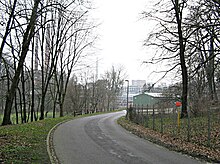Dow Wolff Cellulosics
| Dow Wolff Cellulosics
|
|
|---|---|
| legal form | Business unit |
| founding | 2007 (through takeover ) |
| Seat |
Walsrode ( Walsrode industrial park ) |
| management | Volker Eckhardt ( General Manager ) |
| Number of employees | 2,200 (as of 2007) |
| sales | $ 1 billion (as of 2007) |
| Branch | Chemical industry |
The Dow Wolff Cellulosics GmbH is a company for the production of cellulose products and was on 1 July 2007 as a new business unit of Dow Chemical Company was founded. It emerged from the business activities of the former Wolff Walsrode and the Water Soluble Polymers division of Dow. The company's headquarters are in the early industrialized town of Bomlitz in the southwest of the Lüneburg Heath , where the company now operates the Walsrode industrial park . In addition to other locations in the USA , Belgium , Brazil and several Asian countries, the company also produces in Germany in Bitterfeld-Wolfen , Schkopau and Stade .
The main plant in Bomlitz
location

By far the most important factory location is the Walsrode industrial park in Bomlitz. Here, the working portions extend Altwerk and Kiebitzort almost two kilometers along the Bomlitztales and Fuchsbergstraße and Röpersberg above the northern valley slopes. The settlement development of Bomlitz and the neighboring district of Benefeld was spatially and historically closely linked to the development of the factory facilities.
history
The development of today's factory facilities began in 1815 when the merchants Dr. Leschen, Ludolph Urlaub and August Wolff were founded at the location of the previously abandoned Bommels paper mill, the Leschen, Urlaub & Wolff powder mill . In the beginning black powder was produced , later gun cotton . The co-owners Dr. Leschen and Urlaub soon left the company, so that the Walsrode merchant August Wolff continued the business of the Bomlitz powder factory as the sole owner.
In 1873, the Wolff company, which now operates worldwide, merged with the smaller, nearby powder factory Fallingbostel and the similarly important Rönsahler powder factory in Westphalia . The merger led to Deutsche Pulverfabriken AG zu Rönsahl and Walsrode . In 1876 the powder factory in Rönsahl left the company. This led to the name of Wolff & Co .
After the Treaty of Versailles as a result of the end of the war in 1918, the production of armaments was stopped. The company therefore had to give up the production of explosives and, building on its knowledge of cellulose processing, began manufacturing fiber casings and cell glass, a transparent film based on the French patent for cellophane ( Transparit ).
Due to its competence in powder production, the company received large armaments orders from the Nazi government in the Third Reich . In addition to civilian production, nitrocellulose production was set up in 1935 . In 1938 nitroglycerin production began. During the Second World War , around 8,000 people worked in the Eibia subsidiary , which was founded specifically for powder production, around 80 percent of whom were forced laborers from the occupied territories.
At the end of the Second World War, powder production ceased and the company built on its experience in the production of fibrous casings, films and other cellulose products .
Wolff & Co. became Wolff Walsrode AG in 1974 and was taken over by Bayer AG . In the following years the number of employees reached its highest level to date with almost 4,000 employees.
In 2001 Wolff Walsrode AG was restructured. The formerly closed factory site was opened to other companies as the Walsrode industrial park . More than 20 production and service companies are currently operating here on approximately 130 hectares of fully industrialized terrain.
In June 2007, Wolff Walsrode AG was taken over by Dow Chemical and incorporated into the new Dow Wolff Cellulosics business unit . From October 2013, DWC will be renamed "Dow Pharma & Food Solutions".
Holdings
Dow Wolff Cellulosics has the following subsidiaries:
- Probis GmbH (100%)
See also
literature
- Thorsten Neubert-Preine : "With zeal": From the powder mill to the modern industrial location. 1815-2015. Festschrift for the 200th anniversary of the industrial park Walsrode in Bomlitz , publisher: Dow Deutschland Anlagengesellschaft mbH, Bomlitz 2015
Web links
- Official website ( Memento of September 10, 2013 in the Internet Archive )
- Website of the industrial park Walsrode
- The company as an ammunition factory I
- The company as Munitionsfabrik II on geschichtsspuren.de (formerly lostplaces.de)
Coordinates: 52 ° 54 ′ 16.1 ″ N , 9 ° 39 ′ 41.2 ″ E


